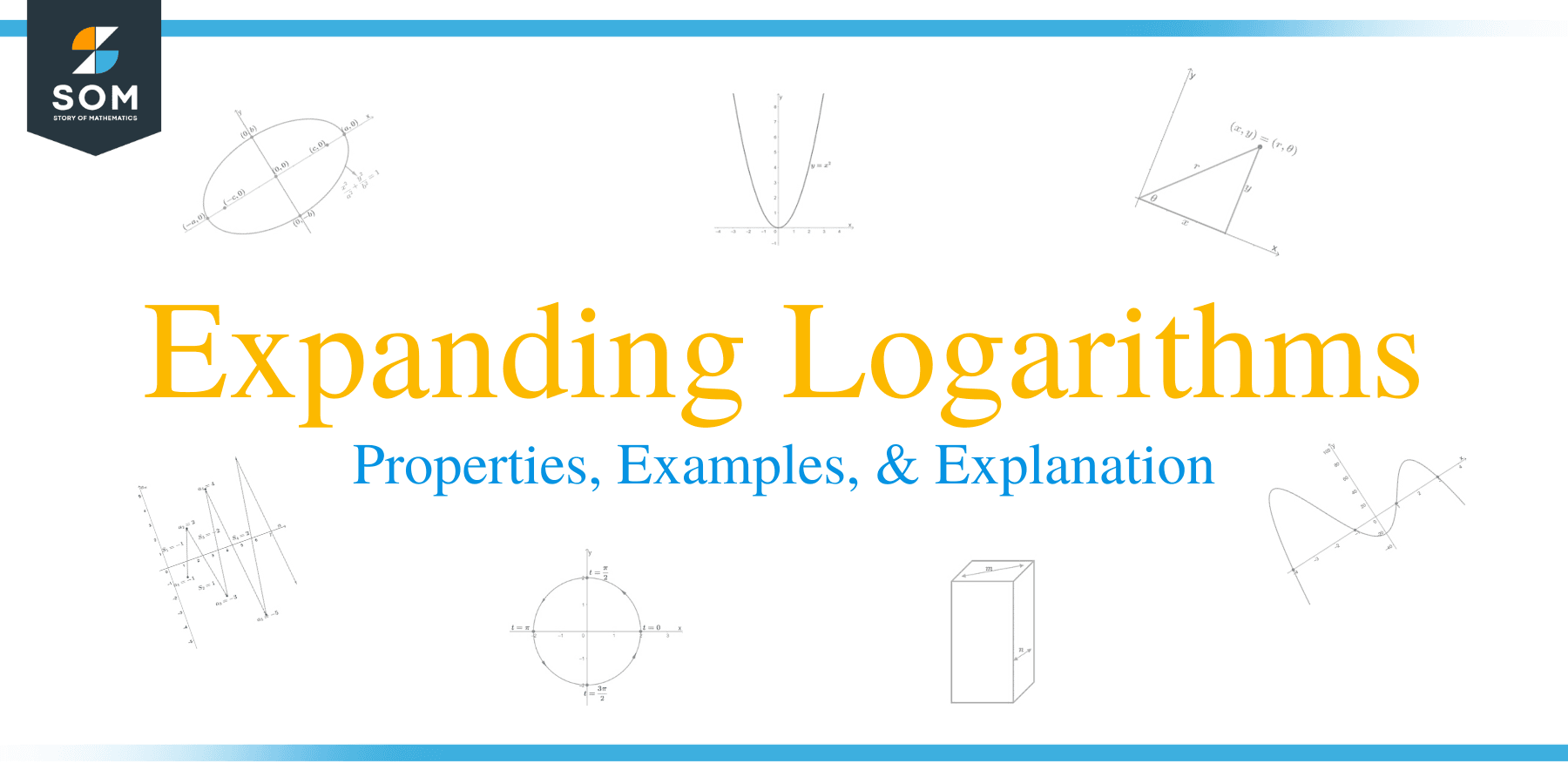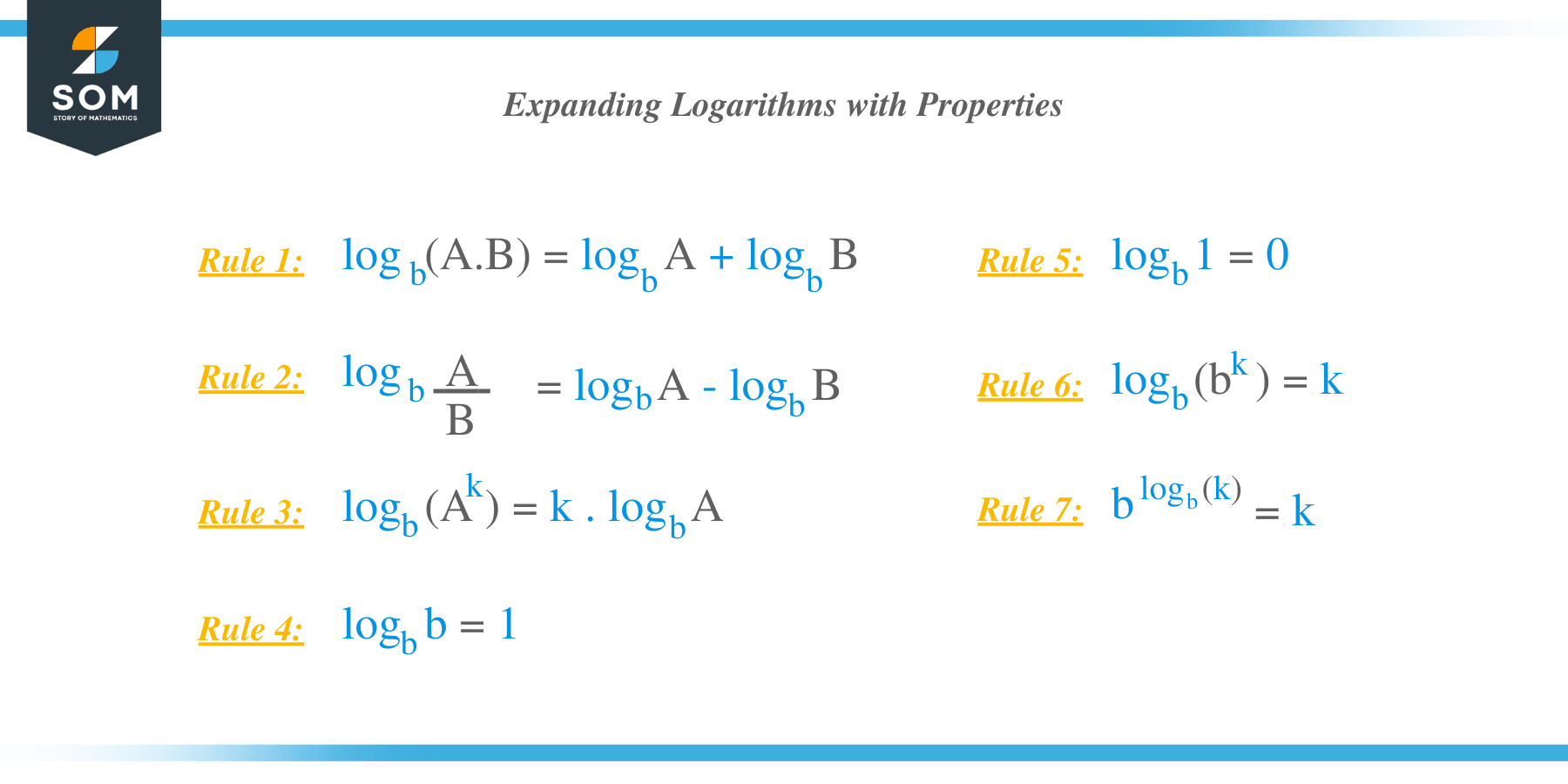- Home
- >
- Expanding logarithms – Properties, Examples, and Explanation
Expanding Logarithms – Properties, Examples, and Explanation
 There are instances when we need to expand logarithmic expressions before simplifying or manipulating the entire expression. This means that learning how to apply logarithmic properties and knowing how to use them to expand logarithmic expressions are essential if we want to master this topic.
There are instances when we need to expand logarithmic expressions before simplifying or manipulating the entire expression. This means that learning how to apply logarithmic properties and knowing how to use them to expand logarithmic expressions are essential if we want to master this topic.
Expand logarithms will test our knowledge of the different logarithmic expressions. This is the process of rewriting a condensed logarithmic expression to a more expanded form using the different logarithmic properties.
As we have mentioned, we will be utilizing the different lessons we’ve learned about logarithms in the past, so make sure to review them as we’ll be using most (if not all) of them.
- Review the different parts and fundamental definitions of logarithms.
- The difference between common and natural logarithms.
- Refresh what you’ve already known about logarithmic rules and properties.
After reviewing these important concepts, let’s go ahead and apply these to start expanding different logarithmic expressions.
How to expand logarithms?
Whenever you’re asked to expand a logarithmic expression, your end goal is to rewrite this expression to reflect the different components present.
\begin{aligned} \color{blue}\log_2 \left(\dfrac{3x^2}{y} \right ) &\Rightarrow \color{red}\log_2 3 + 2\log_2 x – \log_2 y\\ \color{blue}\text{Simplifed}&\Rightarrow \color{red}\boldsymbol{\text{Expanded}}\end{aligned}
The expressions above are good examples showing the difference between a simplified (or condensed) expression to an expanded logarithmic expression. The example that is shown above- made use of three logarithmic properties: product, quotient, and power rules of logarithms.
Why don’t we list down all the helpful properties and rules we might need when expanding logarithms and logarithmic expressions?
| Rule Name | Algebraic Expression |
| Product Rule | $ \log_b({\color{blue} A}{\color{green} B}) = \log_b {\color{blue} A} + \log_b {\color{green} B}$ |
| Quotient Rule | $\log_b\left(\dfrac{\color{blue} A}{\color{green} B}\right) = \log_b {\color{blue} A} – \log_b {\color{green} B}$ |
| Product Rule | $\log_b {\color{blue}A}^n = n\log_b {\color{blue}A}$ |
| Identity Rule | $\log_b b = 1$ |
| Zero Rule | $\log_b 1 = 0$ |
Since logarithmic expressions’ complexities vary throughout, what we can give you are pointers and guides when expanding logarithmic expressions:
- Apply the difference or sum rule right away whenever possible.
- If you see exponents inside the logarithmic expression, then you might need to use the power rule.
- Double-check the new expression and see if each of the components are in their most simplified form.
- If not, expand the component as well.
These are helpful pointers to remember when expanding logarithmic expressions. But of course, the best way to master this skill is by practicing and trying out different examples.
We’ll slowly work through different expressions and see if we can expand each of them using these properties.
Example 1
Expand the logarithmic expression, $\log_3 \dfrac{4x}{y}$.
Solution
Checking the expression inside $\log_3$, we can see that we can use the quotient and product rules to expand the logarithmic expression.
- Apply the quotient rule to break down the condensed expression.
- Since $4x = 4 \cdot x$, we can apply the product rule to expand the expression further.
$\begin{aligned} \log_3 \dfrac{4x}{y} &= \log_3 4x – \log_3 y, \color{green}\text{ Quotient Rule}\\&= \log_3 4 + \log_3 x – \log_3 y, \color{green}\text{ Product Rule}\end{aligned}$
Hence, we have $\log_3 \dfrac{4x}{y} = \log_3 4 + \log_3 x – \log_3 y$.
Example 2
Expand the logarithmic expression, $\log_4 \dfrac{5m^3}{2n^6p^4}$.
Solution
The second expression is a bit more complex than the first one, so let’s begin by expanding the expression starting with the quotient rule then use the product rule for its denominator.
$\begin{aligned} \log_4 \dfrac{5m^3}{2n^6p^4} &= \log_4 5m^3 – \log_4 2n^6p^4, \color{green}\text{ Quotient Rule}\\&= \log_4 5m^3 – (\log_4 2n^6 + \log_4 p^4), \color{green}\text{ Product Rule}\\&= \log_4 5m^3 – \log_4 2n^6 – \log_4 p^4\end{aligned}$
Be careful when distributing the negative sign into the terms to eliminate the parenthesis. Notice that each component still has exponents? This means that we’ll have to apply the power rule to each of the components to expand the expression further.
$ \begin{aligned} \log_4 5m^3 – \log_4 2n^6 – \log_4 p^4 &= 3\log_4 5m – 6\log_4 2n – 4\log_4 p\end{aligned}$
Hence, we have $\log_4 \dfrac{5m^3}{2n^6p^4} = \log_4 5m – 6\log_4 2n – 4\log_4 p $.
Example 3
Expand the logarithmic expression, $\log_2 \left(\dfrac{2x\sqrt{y}}{3z}\right)^6$.
Solution
This expression may appear complicated, but we’ll slowly break down this expression using the different logarithmic properties we’ve learned in the past. Let’s start with the following steps:
- Since we have an exponent outside the rational expression, we should apply the power rule first.
- We can then apply the quotient rule to break down the logarithm of the rational expression.
- Expand $\log_2 2x \sqrt{y}$ and $\log_2 3z$ using the product rule.
\begin{aligned} \log_2 \left(\dfrac{2x\sqrt{y}}{3z}\right)^6 &= 6\left( \log_2 \dfrac{2x\sqrt{y}}{3z} \right ),\color{green}\text{ Power Rule}\\&= 6(\log_2 2x\sqrt{y} – \log_2 3z),\color{green}\text{ Quotient Rule}\\&= 6[(\log_2 2 + \log_2 x + \log_2 \sqrt{y}) – (\log_2 3 + \log_2 z)], \color{green}\text{ Product Rule}\end{aligned}
Inspect each element and see if we can still apply any rules to the current expression. We can rewrite $\sqrt{y}$ as $y^{\frac{1}{2}}$ then apply the power rule.
Expand the negative signs and distribute $6$ to expand the logarithmic expression further.
\begin{aligned} 6[(\log_2 2 + \log_2 x + \log \sqrt{y}) – (\log_2 3 + \log_2 z)]&=6[(\log_2 2 + \log_2 x + \log_2 y^{\frac{1}{2}}) – (\log_2 3 + \log_2 z)],\\ &=6\left[\left(\log_2 2 + \log_2 x + \dfrac{1}{2}\log_2 y\right) – (\log_2 3 + \log_2 z)\right]\\&=6\log_2 2 + 6\log_2 x + 3 \log_2y – 6\log_2 3 – 6\log_2 z\end{aligned}
Hence, the expanded form of $\log_2 \left(\dfrac{2x\sqrt{y}}{3z}\right)^6$ is equal to $6\log_2 2 + 6\log_2 x + 3 \log_2y – 6\log_2 3 – 6\log_2 z$.
Example 4
Expand the logarithmic expression, $\ln \left[\dfrac{4x^2(-2x + 5)}{3x – 4}\right]$.
Solution
Since the expression contains a rational expression, we can consider using the quotient rule right away. Expand the first group using the product rule.
$\begin{aligned} \ln \left[\dfrac{4x^2(-2x + 5)}{3x – 4}\right]&=\ln [4x^2(-2x + 5)] – \ln(3x – 4)\color{green}\text{ Quotient Rule}\\&=\ln 4x^2 + \ln(-2x + 5) – \ln(3x – 4)\color{green}\text{ Product Rule}\end{aligned}$
This is a good time to remind ourselves that we can no longer expand the logarithm of two sums, such as $ln (-2x + 5)$ and $\ln (3x – 4)$.
The first term, $\ln 4x^2$, can still be broken down using the product rule to separate $\ln 4$ and $\ln x^2$ then apply the power rule on $\ln x^2$.
$\begin{aligned} \ln 4x^2 + \ln(-2x + 5) – \ln(3x – 4) &= \ln 4 + \ln x^2 + \ln(-2x + 5) – \ln(3x – 4)\color{green}\text{ Product Rule}\\&= \ln 4 + 2\ln x + \ln(-2x + 5) – \ln(3x – 4)\color{green}\text{ Power Rule}\end{aligned}$
This means that $\ln \left[\dfrac{4x^2(-2x + 5)}{3x – 4}\right] = \ln 4 + 2\ln x + \ln(-2x + 5) – \ln(3x – 4)$ when expanded.
Example 5
Expand the logarithmic expression, $\ln \left[\dfrac{\sqrt{(x + 4)(3x – 2)^2}}{(x^2 – 4)}\right]$.
Solution
This expression may appear complicated to work on, but we’ll be okay as long as we apply the right properties. We can start by applying the quotient rule then rewriting the numerator using the fact that $\sqrt{m} = m^{\frac{1}{2}}$.
\begin{aligned} \ln \left[\dfrac{\sqrt{(x + 4)(3x – 2)^2}}{(x^2 – 4)}\right] &= [\ln \sqrt{(x + 4)(3x – 2)^2}] – \ln (x^2 – 4) \color{green} \text{ Quotient Rule}\\&= \ln[ (x+ 4)(3x – 2)^2 ]^{\frac{1}{2}}- \ln (x^2 – 4) \end{aligned}
We can then apply the power and product rules to expand the first group further. Don’t forget to distribute $\dfrac{1}{2}$ as well.
\begin{aligned} \ln[ (x+ 4)(3x – 2)^2 ]^{\frac{1}{2}}- \ln (x^2 – 4) &= \dfrac{1}{2}\ln \left[ (x+ 4)(3x – 2)^2\right ]- \ln (x^2 – 4) \color{green} \text{ Power Rule} \\&=\dfrac{1}{2} \left[ \ln(x+ 4) + \ln(3x – 2)^2\right ]- \ln (x^2 – 4) \color{green} \text{ Product Rule} \\&= \dfrac{1}{2} \ln(x+ 4) + \dfrac{1}{2}\ln(3x – 2)^2- \ln (x^2 – 4) \end{aligned}
We can still further expand this expression by applying the power rule on $\dfrac{1}{2}\ln(3x – 2)^2$.
$\begin{aligned} \dfrac{1}{2} \ln(x+ 4) + \dfrac{1}{2}\ln(3x – 2)^2- \ln (x^2 – 4) &= \dfrac{1}{2} \ln(x+ 4) + \dfrac{1}{2}(2)\ln(3x – 2)- \ln (x^2 – 4) \color{green} \text{ Power Rule} \\&= \dfrac{1}{2} \ln(x + 4) + \ln(3x – 2) – \ln(x^2 -4)\end{aligned}$
This means that $\ln \left[\dfrac{\sqrt{(x + 4)(3x – 2)^2}}{(x^2 – 4)}\right]$ is also equal to $\dfrac{1}{2} \ln(x + 4) + \ln(3x – 2) – \ln(x^2 -4)$.
Example 6
Expand the logarithmic expression, $\log_3 \left[\dfrac{\sqrt[4]{x^3}}{y^2(x + 3)^5}\right]$.
Solution
Let’s begin by rewriting $\sqrt[4]{x^3}$ as $x^{\frac{3}{4}$ on the numerator then applying the quotient rule to expand the logarithmic expression.
$\begin{aligned} \log_3 \left[\dfrac{\sqrt[4]{x^3}}{y^2(x + 3)^5}\right] &= \log_3 \left[\dfrac{x^{\frac{3}{4}}}{y^2(x + 3)^5}\right]\\&= \log_3 x^{\frac{3}{4}} – \log_3 [y^2(x +3)^5] \color{green} \text{ Quotient Rule}\end{aligned}$
Expand the second term by applying the product rule to distribute the negative sign inside the parenthesis.
$\begin{aligned} \log_3 x^{\frac{3}{4}} – \log_3 [y^2(x +3)^5]&= \log_3 x^{\frac{3}{4}} – [\log_3 y^2 + \log_3 (x +3)^5] \color{green} \text{ Power Rule}\\ &= \log_3 x^{\frac{3}{4}} – \log_3 y^2 – \log_3 (x +3)^5\end{aligned}$
Each term shows expression with exponents, so we can apply the power rule to each of the terms to further expand the logarithmic expression.
$\begin{aligned} \log_3 x^{\frac{3}{4}} – \log_3 y^2 – \log_3 (x +3)^5 &= \dfrac{3}{4}\log_3 x – 2\log_3 y – 5\log_3 (x +3) \color{green} \text{ Power Rule}\end{aligned}$
This means that $\log_3 \left[\dfrac{\sqrt[4]{x^3}}{y^2(x + 3)^5}\right]$, when expanded, is equal to $\dfrac{3}{4}\log_3 x – 2\log_3 y – 5\log_3 (x +3)$.
